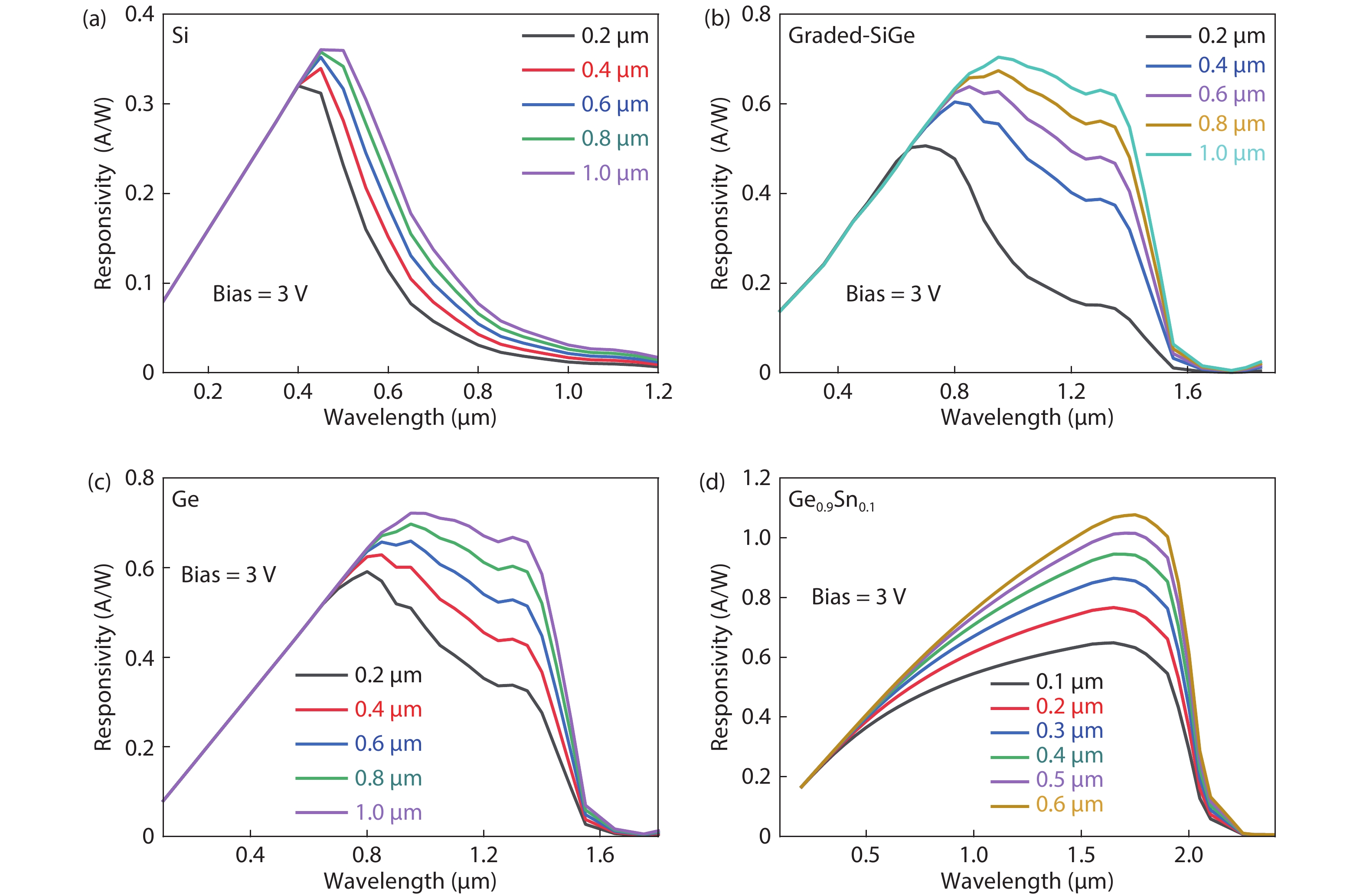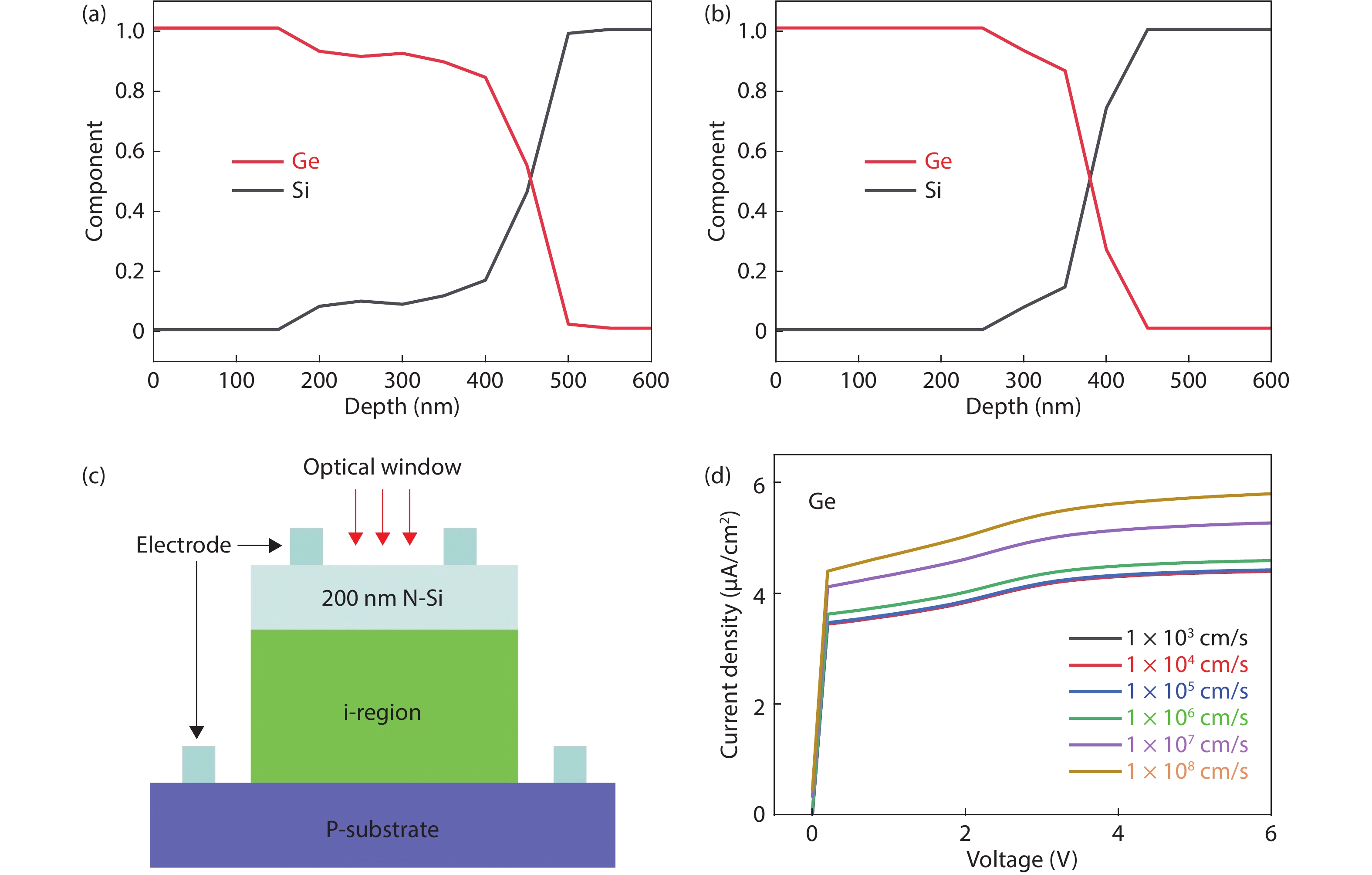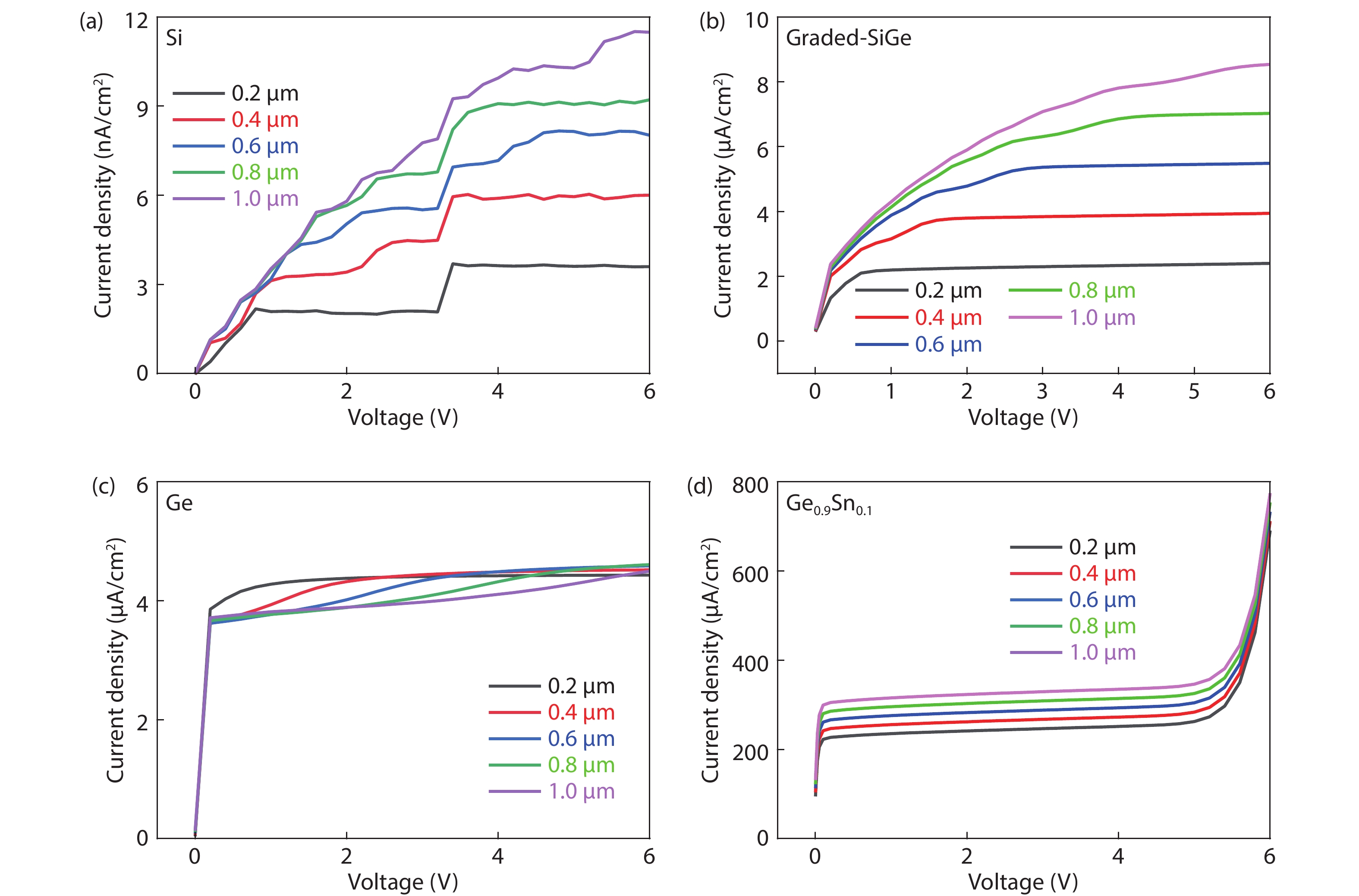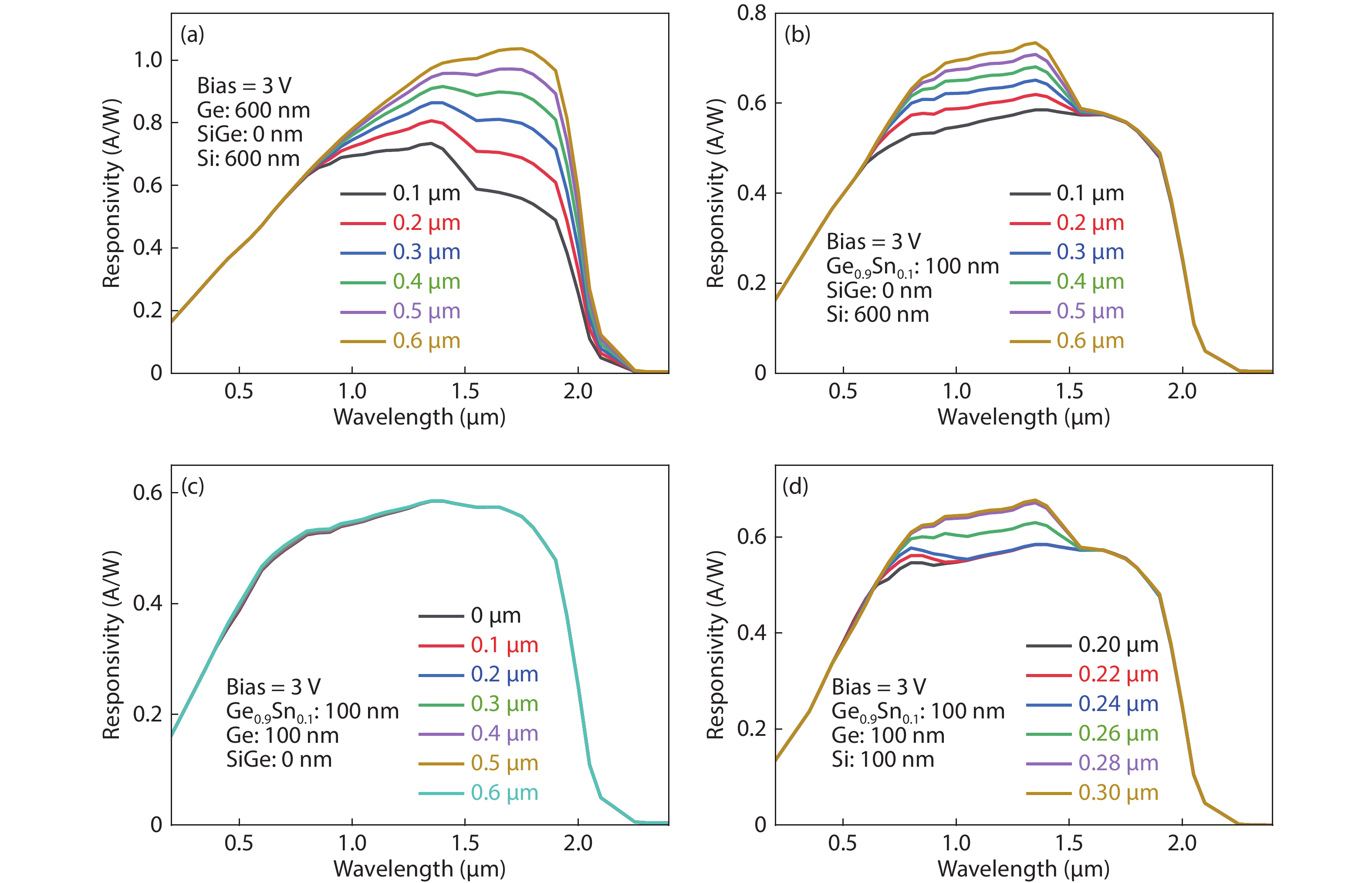| Citation: |
Jinyong Wu, Donglin Huang, Yujie Ye, Jianyuan Wang, Wei Huang, Cheng Li, Songyan Chen, Shaoying Ke. Theoretical study of a group IV p–i–n photodetector with a flat and broad response for visible and infrared detection[J]. Journal of Semiconductors, 2020, 41(12): 122402. doi: 10.1088/1674-4926/41/12/122402
****
J Y Wu, D L Huang, Y J Ye, J Y Wang, W Huang, C Li, S Y Chen, S Y Ke, Theoretical study of a group IV p–i–n photodetector with a flat and broad response for visible and infrared detection[J]. J. Semicond., 2020, 41(12): 122402. doi: 10.1088/1674-4926/41/12/122402.
|
Theoretical study of a group IV p–i–n photodetector with a flat and broad response for visible and infrared detection
DOI: 10.1088/1674-4926/41/12/122402
More Information
-
Abstract
We report a theoretical study of a broadband Si/graded-SiGe/Ge/Ge0.9Sn0.1 p–i–n photodetector with a flat response based on modulating thickness of the layers in the active region. The responsivity of the photodetector is about 0.57 A/W in the range of 700 to 1800 nm. This structure is suitable for silicon-based epitaxial growth. Annealing is technically applied to form the graded-SiGe. The photodetector reaches a cut-off wavelength at ~2300 nm and a low dark-current density under 3 V reverse bias about 0.17 mA/cm2 is achieved theoretical at room temperature. This work is of great significance for silicon-based detection and communication, from visible to infrared.-
Keywords:
- flat response,
- broad response,
- dark current density,
- graded-SiGe,
- Ge0.9Sn0.1
-
References
[1] Eda G, Fanchini G, Chhowalla M. Large-area ultrathin films of reduced graphene oxide as a transparent and flexible electronic material. Nat Nanotechnol, 2008, 3, 270 doi: 10.1038/nnano.2008.83[2] Park S, Wang G, Cho B, et al. Flexible molecular-scale electronic devices. Nat Nanotechnol, 2012, 7, 438 doi: 10.1038/nnano.2012.81[3] de Arquer F P G, Armin A, Meredith P, et al. Solution-processed semiconductors for next-generation photodetectors. Nat Rev Mater, 2017, 2, 16100 doi: 10.1038/natrevmats.2016.100[4] Gong X, Tong M, Xia Y, et al. High-detectivity polymer photodetectors with spectral response from 300 nm to 1450 nm. Science, 2009, 325, 1665 doi: 10.1126/science.1176706[5] Qiao H, Yuan J, Xu Z Q, et al. Broadband photodetectors based on graphene–Bi2Te3 heterostructure. ACS Nano, 2015, 9, 1886 doi: 10.1021/nn506920z[6] Yuan H, Liu X, Afshinmanesh F, et al. Polarization-sensitive broadband photodetector using a black phosphorus vertical p–n junction. Nat Nanotechnol, 2015, 10, 707 doi: 10.1038/nnano.2015.112[7] Hu W, Cong H, Huang W, et al. Germanium/perovskite heterostructure for high-performance and broadband photodetector from visible to infrared telecommunication band. Light: Sci Appl, 2019, 8, 106 doi: 10.1038/s41377-019-0218-y[8] Eckhardt C, Hummer K, Kresse G. Indirect-to-direct gap transition in strained and unstrained SnxGe1–x alloys. Phys Rev B, 2014, 89, 165201 doi: 10.1103/PhysRevB.89.165201[9] Du W, Ghetmiri S A, Conley B R, et al. Competition of optical transitions between direct and indirect bandgaps in Ge1−xSnx. Appl Phys Lett, 2014, 105, 051104 doi: 10.1063/1.4892302[10] Gassenq A, Gencarelli F, van Campenhout J, et al. GeSn/Ge heterostructure short-wave infrared photodetectors on silicon. Opt Express, 2012, 20, 27297 doi: 10.1364/OE.20.027297[11] Cong H, Xue C L, Zheng J, et al. Silicon based GeSn p–i–n photodetector for SWIR detection. IEEE Photonics J, 2016, 8, 1 doi: 10.1109/JPHOT.2016.2607687[12] Su S J, Cheng B W, Xue C L, et al. GeSn p–i–n photodetector for all telecommunication bands detection. Optics Express, 2011, 19, 6400 doi: 10.1364/OE.19.006400[13] Mathews J, Roucka R, Xie J, et al. Extended performance GeSn/Si(100) p–i–n photodetectors for full spectral range telecommunication applications. Appl Phys Lett, 2009, 95, 133506 doi: 10.1063/1.3238327[14] Kouvetakis J, Menendez J, Chizmeshya A V G. Tin-based group IV semiconductors: New platforms for opto- and microelectronics on silicon. Annu Rev Mater Res, 2006, 36, 497 doi: 10.1146/annurev.matsci.36.090804.095159[15] Ke S Y, Ye Y J, Lin S M, et al. Low-temperature oxide-free silicon and germanium wafer bonding based on a sputtered amorphous Ge. Appl Phys Lett, 2018, 112, 041601 doi: 10.1063/1.4996800[16] Ke S Y, Ye Y J, Wu J Y, et al. Interface characteristics and electrical transport of Ge/Si heterojunction fabricated by low-temperature wafer bonding. J Phys D, 2018, 51, 265306 doi: 10.1088/1361-6463/aac7b0[17] Ke S Y, Lin S M, Ye Y J, et al. Bubble evolution mechanism and stress-induced crystallization in low-temperature silicon wafer bonding based on a thin intermediate amorphous Ge layer. J Phys D, 2017, 50, 405305 doi: 10.1088/1361-6463/aa81ee[18] Lin Y, Lee K H, Bao S, et al. High-efficiency normal-incidence vertical p–i–n photodetectors on a germanium-on-insulator platform: Publisher's note. Photonics Res, 2018, 6, 46 doi: 10.1364/PRJ.6.000046[19] Ghetmiri S A, Du W, Conley B R, et al. Shortwave-infrared photoluminescence from Ge1– xSnx thin films on silicon. J Vac Sci Technol B, 2014, 32, 060601 doi: 10.1116/1.4897917[20] Tran H, Du W, Ghetmiri S A, et al. Systematic study of Ge1− xSnx absorption coefficient and refractive index for the device applications of Si-based optoelectronics. J Appl Phys, 2016, 119, 103106 doi: 10.1063/1.4943652[21] Masini C, Calace L, Assanto G, et al. High-performance p–i–n Ge on Si photodetectors for the near infrared: From model to demonstration. IEEE Trans Electron Devices, 2001, 48, 1092 doi: 10.1109/16.925232[22] Rzaev M, Schäffler F, Vdovin V, et al. Misfit dislocation nucleation and multiplication in fully strained SiGe/Si heterostructures under thermal annealing. Mater Sci Semicond Process, 2005, 8, 137 doi: 10.1016/j.mssp.2004.09.027[23] Humlíček J, Garriga M, Alonso M I, et al. Optical spectra of SixGe1–x alloys. J Appl Phys, 1989, 65, 2827 doi: 10.1063/1.342720[24] Braunstein R, Moore A R, Herman F. Intrinsic optical absorption in germanium-silicon alloys. Phys Rev, 1958, 109, 695 doi: 10.1103/PhysRev.109.695[25] Choi D, Ge Y S, Harris J S, et al. Low surface roughness and threading dislocation density Ge growth on Si (001). J Cryst Growth, 2008, 310, 4273 doi: 10.1016/j.jcrysgro.2008.07.029[26] Xia G, Hoyt J L, Canonico M. Si –Ge interdiffusion in strained Si/strained SiGe heterostructures and implications for enhanced mobility metal–oxide–semiconductor field-effect transistors. J Appl Phys, 2007, 101, 044901 doi: 10.1063/1.2430904[27] Gavelle M, Bazizi E M, Scheid E, et al. Study of silicon-germanium interdiffusion from pure germanium deposited layers. Mater Sci Eng B, 2008, 154/155, 110 doi: 10.1016/j.mseb.2008.09.015[28] Luan H, Lim D R, Lee K K, et al. High-quality Ge epilayers on Si with low threading-dislocation densities. Appl Phys Lett, 1999, 75, 2909 doi: 10.1063/1.125187[29] del Alamo J, Swirhun S, Swanson R M. Simultaneous measurement of hole lifetime, hole mobility and bandgap narrowing in heavily doped n-type silicon. Int Electron Devices Meet, 1985, 290[30] Kulin S S, Kurtz A D. Effect of dislocations on minority carrier lifetime in germanium. Acta Metall, 1954, 2, 354 doi: 10.1016/0001-6160(54)90186-8[31] Zhao Y, Wang N, Yu K, et al. High performance silicon-based GeSn p–i–n photodetectors for short-wave infrared application. Chin Phys B, 2019, 28, 128501 doi: 10.1088/1674-1056/ab4e84[32] Kasai I, Hettich H L, Lawrence S L, et al. Wideband anti-reflection coating for indium antimonide photodetector device. European Patent, EP0585055, 1997[33] Chang C, Sharma Y D, Kim Y, et al. A surface plasmon enhanced infrared photodetector based on InAs quantum dots. Nano Lett, 2010, 10, 1704 doi: 10.1021/nl100081j[34] Yang J K, Seo M K, Hwang I K, et al. Polarization-selective resonant photonic crystal photodetector. Appl Phys Lett, 2008, 93, 211103 doi: 10.1063/1.3036954[35] Zhu T F, Liu Z C, Liu Z C, et al. Fabrication of monolithic diamond photodetector with microlenses. Opt Express, 2017, 25, 31586 doi: 10.1364/OE.25.031586[36] Zhong H, Guo A R, Guo G H, et al. The enhanced light absorptance and device application of nanostructured black silicon fabricated by metal-assisted chemical etching. Nanoscale Res Lett, 2016, 11, 1 doi: 10.1186/s11671-015-1209-4 -
Proportional views






 DownLoad:
DownLoad:



















